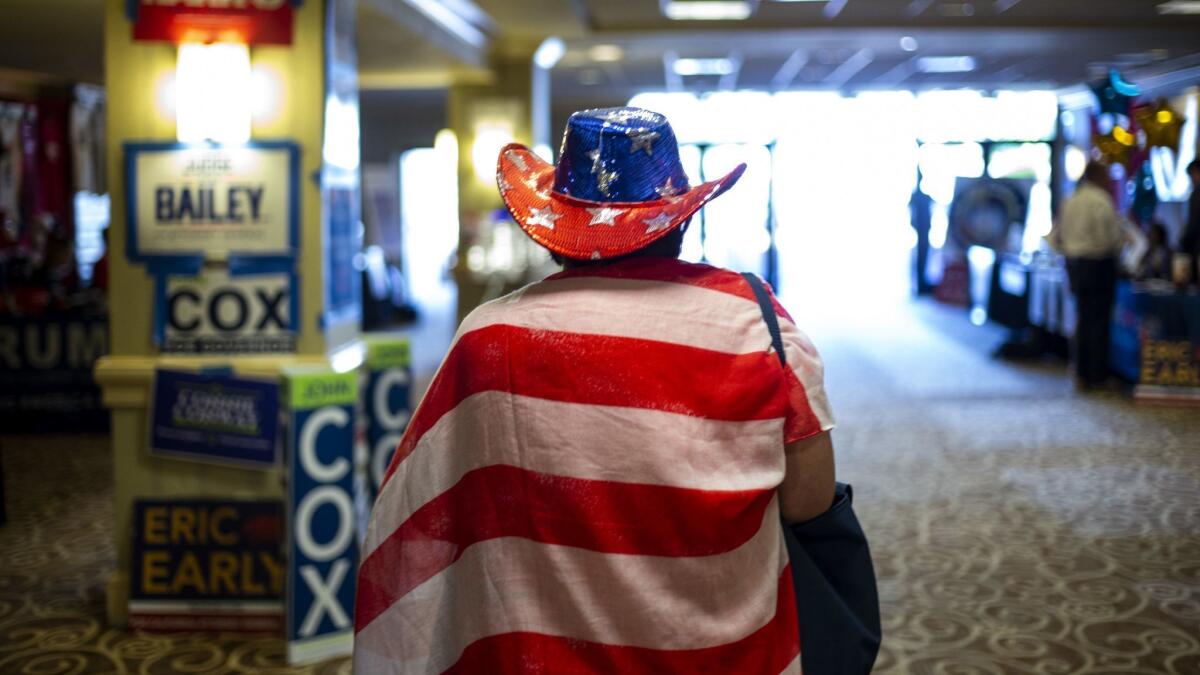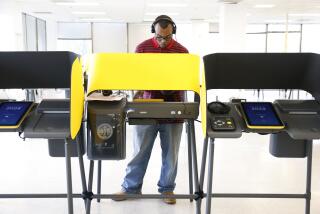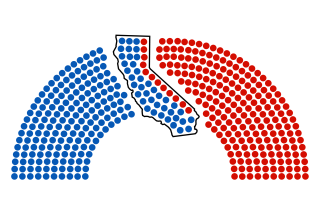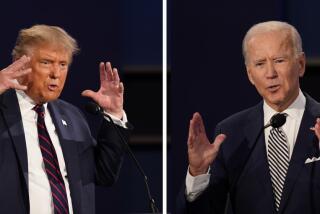As Californians shed their political party labels, independent voters are close to outnumbering Republicans

California Republicans, who haven’t won a statewide election in 12 years and are fighting a pitched battle for the political ground they now hold in the state’s congressional delegation, found themselves facing a new dilemma Thursday.
They are on the edge of losing their decades-old status as the second-largest bloc of the state’s voters, their ranks now only two-tenths of a percentage point greater than those of unaffiliated, “independent” voters.
“The registration numbers are a reflection of how far away this state has slipped for Republicans,” said Rob Stutzman, a longtime GOP strategist.
The latest blow came from the state’s official voter registration report, which showed only 28,649 more Republicans than independent voters as of April 6. Elections officials update state voter tallies at regular intervals before each election; a final report will be issued about two weeks before the June 5 primary.
As a crucial primary nears, track the California races that could flip the House »
The disintegration of strong party affiliation in California has struck a blow to Democrats and Republicans over the last several election cycles. Independent voters, who technically chose “no party preference” on their registration forms, were all but an afterthought as recently as 2002. But in every election for governor since, they’ve grown in size and importance.
“Democrats are keeping stable. That’s not necessarily something to be gloating about,” said Paul Mitchell, one of the state’s leading experts on political data.
Even so, their share of the state’s electorate has grown a few times in recent years, especially in the run-up to the 2016 presidential election. Republicans, by comparison, have been on a steady downward slide. Research from Mitchell’s for-profit company, Political Data Inc., shows that only about 20% of California voters who registered since 2017 chose to be a Republican.
Among the youngest of newly registered voters, between the ages of 18 and 24, the share of Republicans is only 13%. That may be the strongest evidence to date that the party’s problem could worsen as there are fewer older voters.
Matt Fleming, a spokesman for the California Republican Party, said Thursday that there are opportunities to persuade unaffiliated voters. He suggested the increase in independents is more about voters “fed up with the status quo,” which he defined as Democrats who control state government.
Still, the state’s last Republican governor has embarked on an effort that acknowledges the extent of the problem. Former Gov. Arnold Schwarzenegger, who famously told his own state party in 2007 that it was “dying at the box office,” has teamed up with a small group of Republicans to promote candidates who can sell a different message to voters. One of the group’s leaders, Yucca Valley Assemblyman Chad Mayes, said in March the group is looking to help “rational Republicans and centrists” win office in California.
It’s hard for Republicans to win statewide in California without candidates »
Keeping the seats they have, though, is the more immediate problem. Republicans represent only one-third of the state Senate and a slightly smaller portion of the Assembly. They hold just 14 of California’s 53 seats in the House of Representatives, and several of those seats are in danger of flipping to Democrats this fall. Republicans don’t make up the majority of voters in any congressional district in the state. And even Orange County, the state’s most reliable Republican stronghold in the modern era, voted for Hillary Clinton over Donald Trump — the first time the GOP’s nominee lost there since 1936.
“The Republican Party has changed, and it’s unattractive to a lot of voters in California,” Stutzman said.
The embrace of big-money politics by the major parties is among the reasons that Sara Burns, a retired public school teacher, said she changed her registration to be an independent. “Both parties play the same game [and] cooperate with each other to keep their political games going,” said Burns, 60, of Redondo Beach.
Thursday’s registration report from Secretary of State Alex Padilla reported 18.8 million registered voters in California, about 1.2 million more than the gubernatorial primary four years ago. No state comes close to the size of its electorate. U.S. census data show California now has as many voters as did 20 states combined in 2016.
Not all states track political affiliations of registered voters, and California isn’t alone in the growing muscle of independents. In strongly Republican Utah, no-party voters outnumber Democrats by more than three to one. In Democratic Massachusetts, there are five voters “unenrolled” with a party to every registered Republican.
And few states have been as accommodating to voters who want to shed their political party affiliation. California’s top-two primary, enacted by ballot measure in 2010 and now in its fourth election cycle, eliminated the barriers that parties often erected for unaffiliated voters to participate in the selection of candidates appearing on the November ballot.
Here too, though, Republicans have been resistant to change. The new primary rules don’t apply to presidential contests, and state GOP leaders refused to let unaffiliated voters participate in the June 2016 primary that resulted in a decisive Trump victory. Democrats, on the other hand, gave independents the chance to vote for either Clinton or Vermont Sen. Bernie Sanders in their presidential primary.
But unaffiliated voters are not ideologically neutral, say political strategists and researchers. They generally split along traditional party lines when casting ballots, even though they have a disdain for party labels.
The challenge, Stutzman said, is that GOP candidates playing only to the party’s ultra-conservative base can create a self-fulfilling prophecy. He pointed to the Tuesday debate performance of the two major Republican candidates for governor, businessman John Cox and Huntington Beach Assemblyman Travis Allen.
“We’ve gotten to this point where there’s an open seat for governor, and two candidates are on stage bending over backward trying to win a majority of 25% of the electorate,” he said. “They weren’t coming close to a message that can win 51% of all voters.”
One of the most heated topics in the debate was immigration, a perennial sore spot for Republicans in comparison to the broader California electorate.
Cox and Allen both praised Trump’s approach on those who are in the U.S. illegally, a position aligned with GOP sentiments in a March poll by the nonpartisan Public Policy Institute of California. Eighty-two percent of Republican voters in California said the Trump administration’s crackdown on immigration is a “good thing” for the country. By contrast, 55% of self-described moderate likely voters called it a “bad thing.” Opposition to the president’s approach rose to 57% among the youngest voters, 58% among Latinos.
What may save Republican officeholders, for now, is that the remaining party faithful show up to cast their ballots more frequently than do either Democrats or unaffiliated voters. In some places, that can temper the otherwise unbridled enthusiasm of GOP critics.
For now, though, the party’s statewide strength continues to fade as the ranks of unaffiliated voters keep growing.
“This isn’t a revelatory moment,” Stutzman said. “This is where the numbers have been going for several years.”
Times staff writer Michael Livingston contributed to this report.
Follow @johnmyers on Twitter, sign up for our daily Essential Politics newsletter and listen to the weekly California Politics Podcast
More to Read
Get the L.A. Times Politics newsletter
Deeply reported insights into legislation, politics and policy from Sacramento, Washington and beyond. In your inbox three times per week.
You may occasionally receive promotional content from the Los Angeles Times.







